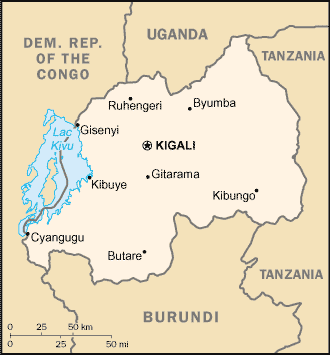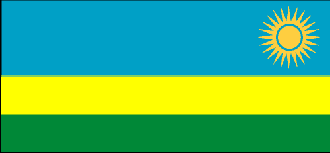
|
Rwanda
Background:
In 1959, three years before independence, the majority ethnic
group, the Hutus overthrew the ruling Tutsi king. Over the next several years
thousands of Tutsis were killed, and some 150,000 driven into exile in
neighboring countries. The children of these exiles later formed a rebel group,
the Rwandan Patriotic Front (RPF) and began a civil war in 1990. The war
culminating in April 1994 in the genocide of roughly 800,000 Tutsis and
moderate Hutus. The Tutsi rebels defeated the Hutu regime and ended the killing
in July 1994, but approximately 2 million Hutu refugees - many fearing Tutsi
retribution - fled to neighboring Burundi, Tanzania, Uganda, and Zaire, now
called the Democratic Republic of the Congo. Since then most of the
refugees have returned to Rwanda.
Location:
Central Africa, east of Democratic Republic of the Congo.
Area: Total: 26,338 sq km land: 24,948 sq km water: 1,390 sq km.
Area - comparative: Slightly smaller than Maryland.
Land boundaries: Total: 893 km, border countries: Burundi 290 km, Democratic
Republic of the Congo 217 km, Tanzania 217 km, Uganda 169 km.
Climate and Terrain:
Temperate; two rainy seasons;
mild in mountains with frost and snow possible.
Mostly grassy uplands and hills; relief is mountainous with altitude
declining from west to east.
People:
Population: 7,312,756.
Ethnic groups: Hutu 84%, Tutsi 15%, Twa (Pygmoid) 1%.
Religions: Roman Catholic 52.7%, Protestant 24%, Adventist 10.4%, Muslim 1.9%,
indigenous beliefs and other 6.5%, none 4.5%.
Languages: Kinyarwanda (official) universal Bantu vernacular, French
(official), English (official), Kiswahili (Swahili) used in commercial centers.
Government:
Government type: Republic; presidential, multiparty system
Capital: Kigali
Economy overview:
Rwanda is a rural country with about 90% of the population
engaged in (mainly subsistence) agriculture. It is the most densely populated
country in Africa; is landlocked; and has few natural resources and minimal
industry. Primary exports are coffee and tea.
Labor force - by occupation: Agriculture 90% .
Industries: Cement, agricultural products, small-scale beverages, soap,
furniture, shoes, plastic goods, textiles, cigarettes.
Agriculture - products: coffee, tea, pyrethrum, bananas, beans, sorghum,
potatoes; livestock.
Statistics:
Telephones - main lines in use: 15,000 (1995)
Radio broadcast stations: AM 0, FM 3.
Radios: 601,000.
Television broadcast stations: 2 (1997)
Televisions: less than 1,000.
Highways: paved: 1,000 km, unpaved: 11,000.
Airports - with paved runways: 4, with unpaved runways: 4.
Return to Visiting Locations
|

